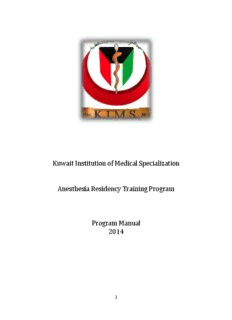
Kuwait Institution of Medical Specialization Anesthesia PDF
Preview Kuwait Institution of Medical Specialization Anesthesia
Kuwait Institution of Medical Specialization Anesthesia Residency Training Program Program Manual 2014 1 Table of contents: I. Welcome from the program director II. Philosophy III. General objectives of the anesthesia residency training program IV. Program Eligibility V. General information Recommended text books Guidelines for resident slating Guidelines for resident OR assignment Chief resident job description Role of the site coordinator Expectations Regarding Incremental Achievement of Goals and Objectives Based on Training Level (PGY2-PGY5 ) VI. Academic half day VII. General objectives of the anesthesia rotations VIII. Rotations descriptions and Objectives IX. Leave policies X. Forms and evaluations 2 I. welcome from the program director: Congratulations and welcome to the anesthesia program, you are among the very few selected and privileged individuals to be trained in the Kuwait board of anesthesia training program. During your journey through the five-year program, you will find it to be both exciting and demanding experience as you seek excellence in this unique and critical specialty. The goal of the program is to make you excellent physicians and anesthetists at a level where you can make critical decisions and manage emergencies. I wish you all the best, Dr. Abdlrahman Alrefaee Program director, Anesthesia Residency Training Program Kuwait Institution of Medical Specialities 3 II. Philosophy The anesthesia residency program of Kuwait Institution of Medical Specialities (KIMS) is dedicated to provide excellence in patients’ care and postgraduate continuous education for our doctors. We hope that all residents will graduate from the program with first class clinical skills and 4 III. General Objectives of the Anesthesia Residency Training Progrm 1. To optimize clinical experience for residents 2. To allow residents to achieve maximum exposure to a wide variety of cases 3. To optimize residents learning and teaching experience 4. To optimize meeting specific education needs or interests for specific residents 5. To allow education and clinical care to be balanced appropriately for residents 6. To allow graded levels of resident responsibility (appropriate for level of training) 7. To allow Senior Resident (Slating Residents) the opportunity to again experience with 8. To provide all residents with experience appropriate for completion of training and examinations, and for future practice 5 IV. Program: Eligibility Residency positions are available mainly to Kuwaiti Citizens as priority but in general few positions will be offered to excellent candidates from other countries. Interviews are held every year select new residents. Candidates must carry Bachelor of Medicine and Surgery(MBBS) or its equivalent from recognized university. Furthermore, completion of one year of general training. 6 V. General information RECOMMENDED TEXT BOOKS BOOK AUTHOR PUBLISHER Introductory: [ Ibrahim Hadi ] Bader Al-Sultan Essence of Anaesthesia are Pain management for medical Student. General: Anesthesia [ RD Miller] Churchill-Livingstone Clinical Anesthesia* [ PG Barash et al ] Churchill-Livingstone Anatomy: Anatomy for the Anesthetist [ Ellis & Feldman] Blackwell Physiology: Textbook of Medical physiology [AC Guyton] W.B.Saunders Review of Medical physiology [ WF Ganong] Lange (Both are classic textbooks) Respiratory physiology: Respiratory physiology-Essentials [ JB West ] Williams and Wilkins Pulmonary Pathophysiology- Essential [ JB West ] Williams and Wilkins Applied Respiratory Physiology [ IF Nunn] Butterworth Medicine: Principles & Practice of Medicine [ Harrison] McGraw-Hill Medicine for Anaesthetists [Vickers] Blackwel Anaesthesia & Co-Existing Disease [ Stoelting & Dierdorf] Churchill-Livingstone 7 Physics & Equipment: Understanding Anaesthesia Equip. Dorsch&Dorsch Williams and Wilkins Anesthesia Equipment: Principles and Application, 2nd edition,Ehrenwerth&Eisenkraft SOURCE TEXT BOOKS FOR THE MCQ’S IN ANESTHESIA General: Clinical Anesthesia,Barash latest edition Anesthesia, Miller, latest edition Pharmacology: Pharmacology and Physiology in Anesthetic Practice, Stoelting latest edition Co-existing Diseases: Anesthesia & Co-existing Disease, Stoelting latest edition Equipment: . Understanding Anesthesia Equipment,Dorsch&Dorsch, latest edition. Cardiac Anesthesia: Cardiac Anesthesia,4th edition,Kaplan OB Anesthesia: Obstetrical Anesthesia: Principles and Practice,2nd edition,Chestnut Pediatric Anesthesia: 8 A Practice of Anesthesia for Infants and Children, Cote,Ryan & Goudsouzian , latest edition Regional Anesthesia: Neural Blockade ,Cousins & Bridenbaugh, latest edition 9 Guidelines for Resident Slating Level of Training Case Type Low- risk , high volume PGY 1 Pre anesthetic clinic 2/ month PGY2- 1 Months Mostly low- risk, high volume 1 -2 moderate- high complexity slates/ month Pre anesthesia clinic 2/ month PGY 2- 2 months Mostly low- risk, high volume 2- 3 moderate- high complexity slates/month Pre Anaesthesia clinic 2/ month PGY 2- 3 months ~50% low- risk high volume ~50% moderate- high complexity slates/ month Pre Anaesthesia clinic ~2/month PGY 2 3+ 3- 4 low risk slates/ month remainder moderate to high complexity graded as per printed guidelines ~1 Preanaesthetic clinic/month PGY 3- 5 Predominantly moderate to high complexity as per printed guidelines Preansthetic clinic ~1/month Subspecialty First choice of cases relevant to subspecialty Rotations This table is intended as a reference for slating residents on site. A more detailed description of the slating priorities is available in the KBA policy. 10
Description: